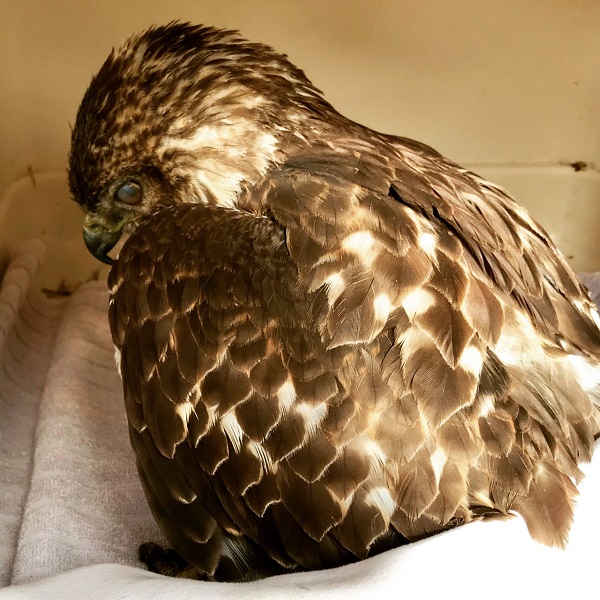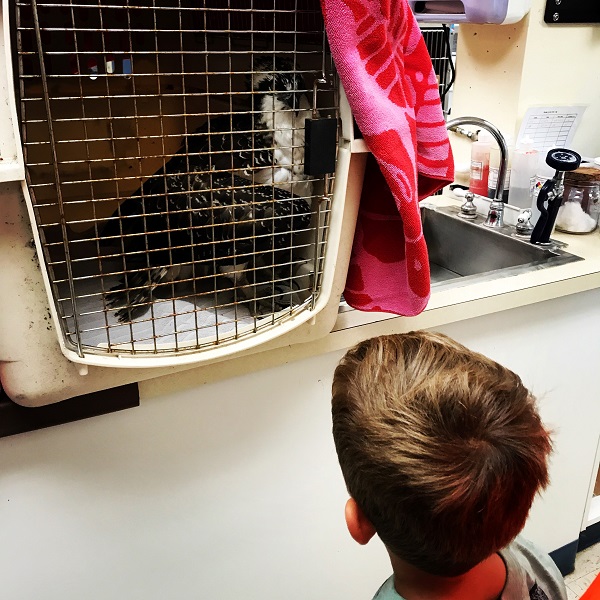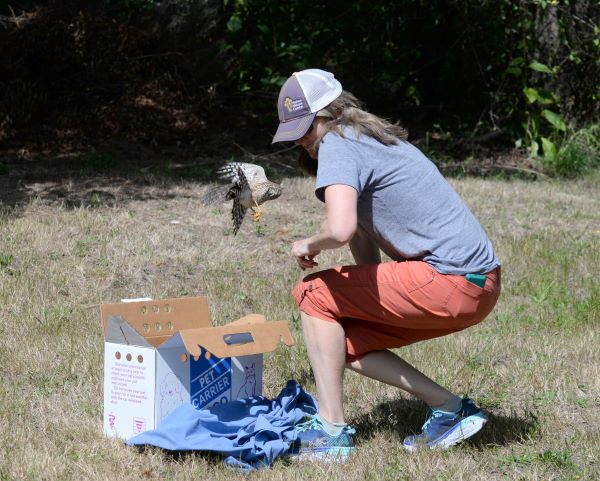I opened the box very slowly as I’d been instructed, mindful of the talons and beak within. As I loosened the last tab and opened the lid, I saw the bird for the first time. It struck me that the hawk was not much bigger than the robins and other passerines she preys upon. Sharp-shinned hawks are stealth forest flyers who zigzag between the trees, swooping in on unsuspecting birds with deadly precision. She had the yellow eyes of a juvenile, which will turn red after her first year—they matched the bright yellow of her feet. It took only a heartbeat for the sharpie to register open blue sky above. I flinched as she flew up and out of the box and toward me before making a sharp turn, and then she was off with the acrobatic integrity of a fighter jet. Thanks to the intervention of caring islanders and expert medical care at PAWS in Lynnwood, this hawk was away to the forest and freedom.
‒ Kathryn True describes participating in the August release of a rehabbed sharp-shinned hawk at Fisher Pond. (Photo by Kelley Keenan.)
Every morning in Lynnwood, a doctor and her team hold rounds for a special set of patients—some of them from Vashon. Like in other area hospitals, they assess the needs of each individual, discussing who is ready for discharge and who needs new interventions. The difference is that these patients are all of different species and on any given day they might include an orphaned baby harbor seal, a black bear recovering from smoke inhalation, or a great blue heron with a broken wing—the hospital is PAWS and the doctor is a vet.
Since 2010, PAWS specialists have cared for 65 patients from Vashon-Maury representing 26 species including varied thrush, black-headed grosbeak, Douglas squirrel, mallard, barn owl, river otter, and belted kingfisher. This is in addition to injured animals found here and delivered for care and rehabilitation to West Sound Wildlife Shelter on Bainbridge Island or to Sarvey Wildlife Care Center in Arlington.
These animals are gifted a second chance at life thanks to a group of island volunteers, including Kelly Keenan, Vashon Nature Center’s (VNC) wildlife first responder.
“In an emergency situation, getting the animal to the facility is half the battle, sometimes it’s a matter of life-or-death,” she says. “The animal needs care in a timely manner so it’s less stressed and has a better chance of survival—the goal is for them to recover, return to the island, and to be set free.”
Transportation is Keenan’s biggest obstacle and she is looking for islanders willing to act as an animal ambulance service on a moment’s notice. PAWS has twice daily pickups at Seattle Animal Shelter in Interbay, making it easier for those who can’t make a trip to Lynnwood, though Keenan prefers to deliver animals directly to PAWS, so they receive medical intervention immediately.
Though each situation is different, a rescue usually begins with a phone call. On Aug. 2, Keenan was contacted about an injured sharp-shinned hawk someone had found on the ground near Fisher Pond and brought to Fair Isle Animal Clinic. The clinic does not care for wild animals, but staff there called Keenan, who picked up the hawk in one of a fleet of animal carriers she uses for this purpose. It was late in the day, so there was no time to head to PAWS.
“I didn’t think the hawk was going to make it. It wasn’t perching at all but was lying down and I worried about it all night,” she says. “When I checked on it in the morning it was alive and tracking me with its head, but still lying down.”
Early that morning, a volunteer delivered the hawk to PAWS. Keenan says transporting a wild animal is always a powerful experience.
“Anyone who has done it feels a particular energy, it’s hard to explain or put into words,” she says. “Even though you can’t see the animal because it’s in a covered carrier, you feel this connection.”

Keenan, who also runs the VNC Salmonwatcher Program, became a wildlife rescuer because she loves people and animals.
“I’m a life-long learner and wildlife is important to me,” she says. “I like learning as much as I can about the animals’ habitat, food sources, how they were injured, and maybe how to prevent injuries in the future.”
One of her information sources is Jeff Brown, a PAWS wildlife naturalist and biologist whose job includes assessing animals before release, determining the safest release location, and releasing the animals. During the busy season from April through September, Jeff and his PAWS colleagues care for up to 400 animal inpatients a day, from hummingbirds to ospreys to bobcats.
“We are a nonprofit without resources for transport so we rely on the public, and the majority of our patients come from people who bring them in,” he says, stressing that people should always call first before they approach or move a wild animal. Often well-meaning individuals “rescue” juveniles that are being cared for by parents nearby or intervene when the best thing to do is to leave an animal alone.
“Fledgling crows, for instance, are often misidentified as injured at the stage when they can’t fly well and are still being regularly fed by their parents,” Brown says. “We receive multiple calls per day during the fledgling season about healthy fledglings.”
He encourages people to call for advice, 8 am to 8 pm seven days a week (8 am to 5 pm, Oct.‒May), including holidays (see sidebar). A PAWS specialist can provide tips whether to disturb the animal or how to safely capture an injured animal.
Thankfully, the Vashon hawk survived the trip to PAWS where the vet determined she was a first-year female, likely hit by a vehicle. The veterinarian suspected that head trauma was impairing her movement, causing weakness in her legs that prevented her from standing. The hawk’s treatment plan included medication for nerve pain and inflammation, fluids, food, and a safe, quiet place to recover. She was perching and using her legs normally after four days of care and continued to improve after that.
Sharp-shinned hawks are members of a group of hawks called accipiters—fast, agile flyers (with top speeds recorded at 60 MPH!) that prey on smaller birds by pursuing them acrobatically through the forest. Brown says these birds are especially energetic and react to human presence more than other birds of prey, so he takes special care when working with them to keep them from harming themselves.
The young sharpie’s recovery went smoothly, and just 10 days later she passed her final flight test, indicating to Brown that she could function normally back in the wild. Once the hawk was cleared for takeoff, Brown contacted Keenan and invited her to witness the release the following day.
“I try to contact the finder and see if they want to come out for the release because it wouldn’t be happening if they didn’t put in the effort to bring it in. One of the most enjoyable parts of my job is getting to see animals returned to the wild,” Brown says. “It’s amazing to see how many people in our community are willing to help wild animals in distress.”
During the spring and summer, Keenan receives a call or two a week from people with wildlife injury questions. Keenan and her youngest son, Brody, 6, who has grown up being Keenan’s amenable rescue assistant, met Brown at Fisher Pond, where the hawk was found originally. After the carrier was opened, the young bird took only seconds to see open blue sky above, launch up and out of the box, and away into the trees surrounding the pond. As she scanned the trees with her camera to catch a glimpse of the hawk, Keenan who has also been at the release of a few bald eagles, a barn owl, and a belted kingfisher, reflected on this latest success story.

“It’s always a pleasant surprise when you think it didn’t go well and then the animal recovers and can be released—it’s like you win the lottery for that one,” says Keenan, who helped launch VNC’s barn owl cam and has a special fondness for birds of prey. “They are such majestic, amazing birds—so captivating.”
She appreciates islanders who are always looking out for animals and encourages people to call with any questions about an animal that may be injured.
“I am so happy people are out there noticing nature, watching out for animals, and doing their best to help when a situation looks dire,” Kennan says. “I am thankful for everybody who helps out and encourage anyone who wants to get involved to volunteer to join our transport team.”
If you find injured wildlife:
Stop and take a breath and keep your pets away. Assess the situation. Does the animal appear in distress? Do you need more info? Call for advice and help:
- If it is a marine mammal, (injured, stranded, or dead), call: Ann Stateler, local NOAA Marine Mammal Stranding coordinator: 206-463-9041.
- For all other injured wildlife, call PAWS: 425-787-2500.
- If it is after hours or you can’t reach anyone, call islanders Kelley Keenan at 281-222-8282, or Amy Carey at 206-755-3981.
If you would like to become an island wildlife transporter, email
Keenan at: kellykeenan.vnc@gmail.com.

